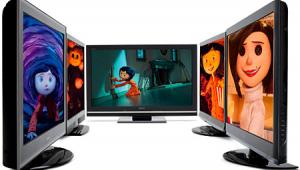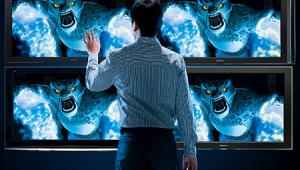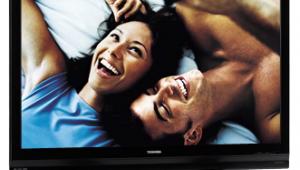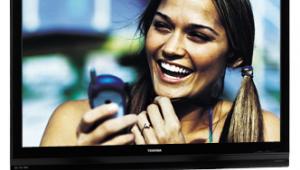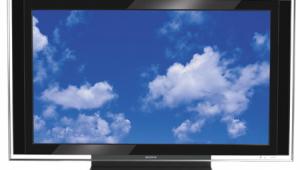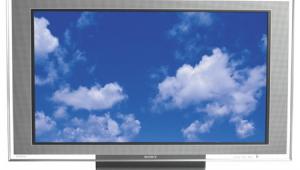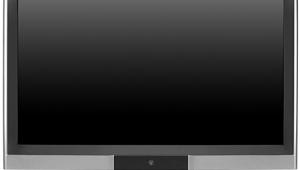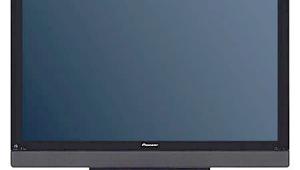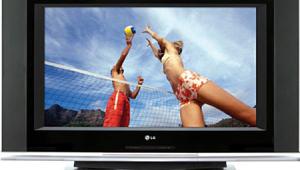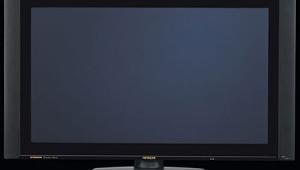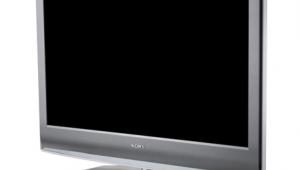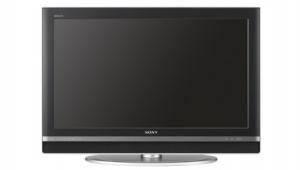Sharp Aquos LC-45GX6U integrated digital HDTV
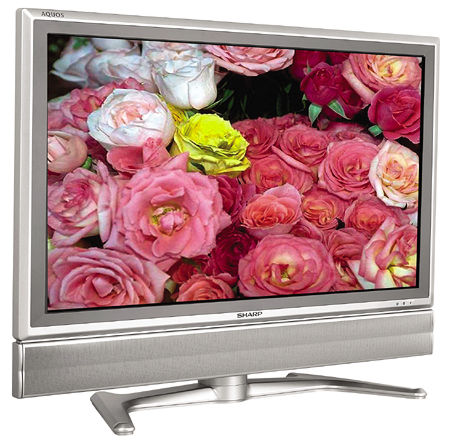
However, once screens get up to 40 inches diagonal, the list of LCD sets gets a lot shorter, and Sharp Electronics is certainly a player with their Aquos LC-45GX6U. It takes a lot of work to make an LCD panel this big without defects; the costs right now are commensurately higher than with plasma monitors. The payoff is that you gain higher native resolution than you'd find in a plasma display of the same size. At present, the highest pixel density for plasma monitors and TVs in sizes up to 63 inches is 1366x768 pixels. In comparison, the LC-45GX6U boasts a native 1920x1080 pixel array, which makes it both the largest and the highest-resolution LCD display I've ever tested.
But the Aquos LC-45GX6U is more than just a large, high-resolution LCD TV. It also has built-in digital cable and off-air tuners, accepts a wide variety of analog and digital video input signals, and can read and record to several digital memory-card formats. In short, it's a full-blown media center—unless you want multichannel sound, all you need is a DVD player and you're in business.
Out of the Box
The Aquos LC-45GX6U continues the style enhancements of the Aquos line, with an attractive dark-silver finish and a companion speaker array directly under the screen. A sturdy swivel stand is included in the price. The housing is made slimmer yet by the use of three umbilicals to carry video and audio signals to the screen from the separate TU-GD10U-T AV control center. The three cables couldn't differ more from each other: one resembles an S-video cable on steroids, while the other two look like DVI and HDMI cables.
When in place, two plastic covers hide all of these connections, as well as the power cord and speaker hookups. The interconnects are long enough (about 12 feet) to give you some flexibility in placing the TV where you want it, but they're bulky. If you have the control center near the set, you'll need to tie up the excess cable and dress it out of the way.
The TU-GD10U-T provides a host of connections. There are two analog RF inputs and one RF loop-through connection for analog cable or off-air signals. There's also a single digital RF input, and that's where your digital cable or terrestrial signals go. (Sorry, you can't have both unless you use an external antenna switch.)
Interestingly, the LC-45GX6U's built-in digital cable tuner received a bunch of unscrambled signals off my Comcast system, including all of my local stations. These programs don't show up as normal cable channels on-screen; only their physical channel numbers are displayed (i.e. 81-2 and 83-4). However, the LC-45GX6U did not pick up all of the available off-air stations during a channel scan. I had to go back and manually enter several digital channels, including very strong signals from local ABC, WB, PBS, and NBC affiliates.
Because the LC-45GX6U is a fully integrated digital TV, you can simply hook up your antennas or a CableCARD and do nothing more. But if you have other components, you can hook them up to one of two component (Y-Pb-Pr) or composite inputs, a single S-video input, a DVI-I input, and an HDMI input. All of these inputs also have companion analog audio inputs using RCA jacks or mini jacks. The DVI-I input can accept digital PC (DVI), Digital AV (DVI-HDCP), analog PC, or analog AV (Y-Pb-Pr), though the last two require appropriate adapter cables.
There's also a digital audio output (TosLink) to drive an external AV receiver. This provides a digital audio connection from an HDMI, digital cable, or digital terrestrial source only—there are no other ways to run digital audio through this box.
For those readers into D-VHS recording, the Sharp's two i.Link (IEEE1394) jacks can be connected to as many as 16 compatible devices, including camcorders and D-VHS recorders and players. The TU-GD10U-T will automatically recognize and control any of these components through the supplied remote control. I didn't test the i.Link interfaces other than to see if they would recognize and operate my JVC HM-DH30000U D-VHS player. They did.
Remote and Menus
The supplied remote control is shaped like a long, flat wand. Its button layout is a bit too busy for my tastes, but navigation is pretty simple. You won't have direct access to any input, though—you have to bring up a list of inputs and scroll through them, although they can have custom labels.
Direct access is provided to either of the analog antenna inputs and the sole digital RF input. You can also build a list of favorite channels for surfing. Four color-coded buttons on the remote bring you to these lists, which can memorize a maximum of four stations in each, for a total of 16.
Another button provides access to the built-in memory-card reader, which supports all of the popular types, including SD, XD, and CompactFlash. You can also see a list of available digital cable and off-air stations for fast surfing, once you've either installed a CableCARD or done an off-air channel scan.
The menus provide an interesting but inconsistent array of image and signal adjustments. Right away, I noticed that there are no RGB drive or bias settings (adjustments to calibrate the color temperature at both the top and bottom of the brightness range) in any mode except for RGB (PC). If you're watching any type of video program, analog or digital, all you can do to change white balance is select from five different factory-preset Color Temperature settings, of which one works reasonably well.
In addition to the usual basic image adjustments, you can also set the brightness of the Aquos LC-45GX6U's backlight. This control really cranks up the footlamberts, but also raises black levels across the board, so caveat emptor. There are also two sets of Sharpness controls, one of which claims to make background images more detailed.
When watching digital programs, you'll have access to two noise filters. One is a 3D adaptive noise filter that does work but softens images. The other is a two-level mosquito-noise filter intended to clean up MPEG compression artifacts in digital TV programs.
One of the more intriguing menu adjustments is Sharp's Color Management System (CMS). This three-step menu lets you individually set Red, Green, Blue, Cyan, Magenta, and Yellow Saturation, Brightness, and Hue for different inputs, and save your settings into memory. There may be a value to this when looking at still images from a computer, but I'd hesitate to use it to correct analog and digital video color. Assuming the source video program was encoded correctly, digital SDTV and HDTV programs shouldn't need any correction at all—only white-balance adjustments.
Four aspect ratios are available for almost every type of signal: 4:3 with sidebars, Stretch (anamorphic), Smart Stretch (edges more than center), and Zoom (fills the screen with letterboxed material). Some of these modes work even with 720p and 1080i programs.
There are also six picture/gamma settings, five of which (Standard, Movie, Game, User, and Dynamic) can be tweaked. The sixth setting, Dynamic Fixed, really isn't appropriate for home theater use—it's quite bright, and the color temperature is very cold.
The built-in stereo speakers are rated at a comfortable 10Wpc and performed well in small to mid-sized rooms. The Dolby "virtual" surround mode can be activated from the remote, but placement of the TV is critical for this feature to work. I stuck with conventional 2-channel playback.
